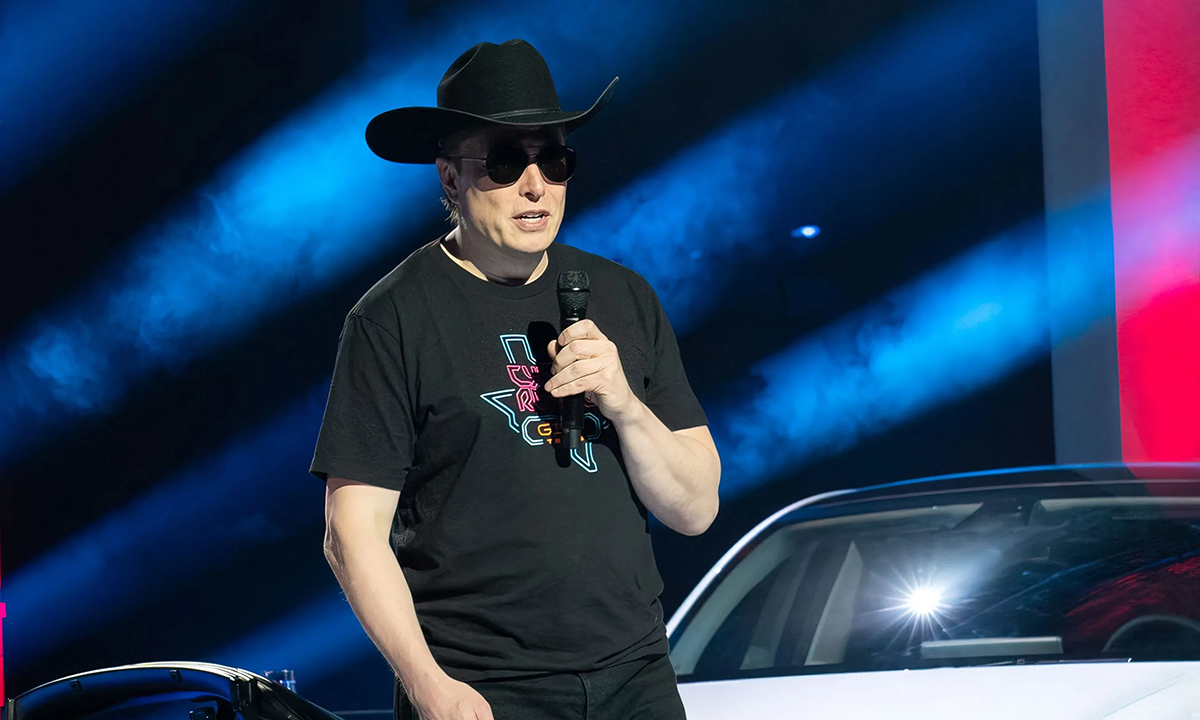印度的电动汽车开始崛起,有望抢夺特斯拉市场份额

“特斯拉公司(Tesla)不会在任何不允许我们销售和维护汽车的地方建厂。”埃隆·马斯克最近在推特上回应关于其印度计划的问题时表示。就像马斯克最近说的其他一些事情一样,这并没有反映现实。
印度中央政府和许多邦一直在不遗余力地设法让特斯拉公司在印度建制造工厂,从而利用该国巨大的市场潜力。马斯克想要的是一份进口中国制造的汽车而无需缴纳任何关税的许可证,这可以让马斯克在与其他汽车制造商的竞争中拥有优势,而印度却没有准备好提供这份许可证。
另外,印度正在开发新一代面向大众的电动汽车,有望主导全球市场。这些电动汽车融合了最新的技术突破——不像特斯拉汽车,特斯拉汽车的基础技术已经有十多年的历史了,除了一些软件升级和危险的自动驾驶技术之外,什么都没有。
对印度来说,在这个技术飞速发展的时代,特斯拉汽车就像20世纪50年代印度大使牌(Hindustan Ambassador)老式汽车一样过时,后者在80年代中期之前一直在印度占据主导地位。塔塔汽车公司(Tata Motors)开发的概念车Avinya是特斯拉公司在6年前就应该开发的车型。马欣德拉公司(Mahindra)将于今年7月推出的“Born Again”电动汽车可能与特斯拉车型一样功能强大,但价格不到特斯拉的一半。鉴于这些公司已经拥有全球影响力——塔塔汽车公司拥有捷豹汽车(Jaguar),马欣德拉公司是最大的拖拉机和皮卡供应商之一——本人迫切地期望这些产品在美国上市。
在你把我当成另一个做空特斯拉的人或别有用心的人之前,让我先说明一下我和马斯克的私人交情和特斯拉汽车的使用体验。
在2012年马斯克让我排在候补名单的前列之后,我成了Model S的首批购买者之一。在洛杉矶福克斯电影制片公司(Fox Studios)举办的一场讨论会中,马斯克为我的第一本书《移民外流》(Immigrant Exodus)背书,并可能第一次透露了他想在火星退休的计划。那时候,特斯拉公司濒临破产,马斯克不断受到持怀疑态度的记者的抨击,尤其是《纽约时报》的记者。在《华盛顿邮报》的一篇文章中,我自称是“特斯拉粉丝”,对Model S赞不绝口,称其为“轮子上的宇宙飞船”。随后,我写了很多文章称赞马斯克,并为他辩护。
我还在2016年卖掉了我的旧特斯拉,买了一辆新的,以便为马斯克所说的将在两年内增加自动驾驶功能的软件升级做好准备。他的销售主管发来的电子邮件证实,我购买的汽车配备了特斯拉所谓的全自动驾驶功能 (FSD) 所需的所有硬件。
软件升级一直没有到来。特斯拉的技术与六年前基本相同。现在我被告知,如果我想要实现全自动驾驶功能,我需要再买一辆新车。更糟糕的是,特斯拉公司要求消费者在虚高的汽车价格基础上再支付1.2万美元,才能实现全自动驾驶功能。坦率地说,鉴于许多关于特斯拉撞车事件的报道和我所经历的负面经历,我不再相信该公司所说的任何事情。特斯拉汽车的自动驾驶系统曾把我的车撞到车库门上,我在路上遇到过很多次侥幸脱险的经历,包括在美国公共电视网新闻时间(PBS NewsHour)的保罗·索曼(Paul Solman)拍摄的一个片段中,我对着特斯拉汽车大发雷霆。
我认为特斯拉的技术永远不会实现安全自动驾驶,因为它缺乏合适的传感器,而主要依赖老一代的摄像头。但像Waymo公司和Cruise公司这样使用更先进的激光雷达传感器、行事更谨慎的公司可能会实现安全自动驾驶。我甚至买了一辆Model X,因为我想要更现代的外观和感觉——但我退了它,因为它的内饰似乎是由廉价塑料制成的,而且这辆车有设计缺陷。
因此,在爱上特斯拉汽车十年之后,我准备放弃了。
印度没有特斯拉公司在美国和中国建造的超级工厂,因此,在电池生产方面可能会落后。但在这方面,时间和技术也可能站在印度这一边。这场竞赛的黑马是信实集团(Reliance)的穆克什·安巴尼(Mukesh Ambani),他最近以1亿英镑的价格收购了一家英国公司Faradion公司。在电子邮件交流中,我推测他有在全球推广钠离子电池的野心。
Faradion公司的钠离子电池有着与特斯拉汽车使用的锂电池几乎相同的能量密度和功率——但生产成本极低,而且不会对环境造成破坏,这是因为钠资源丰富且易于获取。对于电动汽车制造商来说,付出增加电池质量的微小代价可能是值得的,因为世界上大多数人并不需要300英里的续航里程,而这似乎是美国消费者想要的。钠离子电池在寒冷环境下的性能也更好,并且不受导致锂离子电池起火的热失控的影响。
马斯克坚持印度政府无法接受的条件,这可能是给印度的一份大礼:这将为印度汽车行业提供必要的发展空间,从而制造出将席卷全球汽车行业的汽车,而这些汽车会夺取特斯拉公司的市场份额。(财富中文网)
维维克·瓦德瓦是一位学者、企业家和作家。他的最新著作《从增量到指数》(From Incremental to Exponential)解释了大公司如何看待未来并重新思考创新。
译者:中慧言-王芳
“特斯拉公司(Tesla)不会在任何不允许我们销售和维护汽车的地方建厂。”埃隆·马斯克最近在推特上回应关于其印度计划的问题时表示。就像马斯克最近说的其他一些事情一样,这并没有反映现实。
印度中央政府和许多邦一直在不遗余力地设法让特斯拉公司在印度建制造工厂,从而利用该国巨大的市场潜力。马斯克想要的是一份进口中国制造的汽车而无需缴纳任何关税的许可证,这可以让马斯克在与其他汽车制造商的竞争中拥有优势,而印度却没有准备好提供这份许可证。
另外,印度正在开发新一代面向大众的电动汽车,有望主导全球市场。这些电动汽车融合了最新的技术突破——不像特斯拉汽车,特斯拉汽车的基础技术已经有十多年的历史了,除了一些软件升级和危险的自动驾驶技术之外,什么都没有。
对印度来说,在这个技术飞速发展的时代,特斯拉汽车就像20世纪50年代印度大使牌(Hindustan Ambassador)老式汽车一样过时,后者在80年代中期之前一直在印度占据主导地位。塔塔汽车公司(Tata Motors)开发的概念车Avinya是特斯拉公司在6年前就应该开发的车型。马欣德拉公司(Mahindra)将于今年7月推出的“Born Again”电动汽车可能与特斯拉车型一样功能强大,但价格不到特斯拉的一半。鉴于这些公司已经拥有全球影响力——塔塔汽车公司拥有捷豹汽车(Jaguar),马欣德拉公司是最大的拖拉机和皮卡供应商之一——本人迫切地期望这些产品在美国上市。
在你把我当成另一个做空特斯拉的人或别有用心的人之前,让我先说明一下我和马斯克的私人交情和特斯拉汽车的使用体验。
在2012年马斯克让我排在候补名单的前列之后,我成了Model S的首批购买者之一。在洛杉矶福克斯电影制片公司(Fox Studios)举办的一场讨论会中,马斯克为我的第一本书《移民外流》(Immigrant Exodus)背书,并可能第一次透露了他想在火星退休的计划。那时候,特斯拉公司濒临破产,马斯克不断受到持怀疑态度的记者的抨击,尤其是《纽约时报》的记者。在《华盛顿邮报》的一篇文章中,我自称是“特斯拉粉丝”,对Model S赞不绝口,称其为“轮子上的宇宙飞船”。随后,我写了很多文章称赞马斯克,并为他辩护。
我还在2016年卖掉了我的旧特斯拉,买了一辆新的,以便为马斯克所说的将在两年内增加自动驾驶功能的软件升级做好准备。他的销售主管发来的电子邮件证实,我购买的汽车配备了特斯拉所谓的全自动驾驶功能 (FSD) 所需的所有硬件。
软件升级一直没有到来。特斯拉的技术与六年前基本相同。现在我被告知,如果我想要实现全自动驾驶功能,我需要再买一辆新车。更糟糕的是,特斯拉公司要求消费者在虚高的汽车价格基础上再支付1.2万美元,才能实现全自动驾驶功能。坦率地说,鉴于许多关于特斯拉撞车事件的报道和我所经历的负面经历,我不再相信该公司所说的任何事情。特斯拉汽车的自动驾驶系统曾把我的车撞到车库门上,我在路上遇到过很多次侥幸脱险的经历,包括在美国公共电视网新闻时间(PBS NewsHour)的保罗·索曼(Paul Solman)拍摄的一个片段中,我对着特斯拉汽车大发雷霆。
我认为特斯拉的技术永远不会实现安全自动驾驶,因为它缺乏合适的传感器,而主要依赖老一代的摄像头。但像Waymo公司和Cruise公司这样使用更先进的激光雷达传感器、行事更谨慎的公司可能会实现安全自动驾驶。我甚至买了一辆Model X,因为我想要更现代的外观和感觉——但我退了它,因为它的内饰似乎是由廉价塑料制成的,而且这辆车有设计缺陷。
因此,在爱上特斯拉汽车十年之后,我准备放弃了。
印度没有特斯拉公司在美国和中国建造的超级工厂,因此,在电池生产方面可能会落后。但在这方面,时间和技术也可能站在印度这一边。这场竞赛的黑马是信实集团(Reliance)的穆克什·安巴尼(Mukesh Ambani),他最近以1亿英镑的价格收购了一家英国公司Faradion公司。在电子邮件交流中,我推测他有在全球推广钠离子电池的野心。
Faradion公司的钠离子电池有着与特斯拉汽车使用的锂电池几乎相同的能量密度和功率——但生产成本极低,而且不会对环境造成破坏,这是因为钠资源丰富且易于获取。对于电动汽车制造商来说,付出增加电池质量的微小代价可能是值得的,因为世界上大多数人并不需要300英里的续航里程,而这似乎是美国消费者想要的。钠离子电池在寒冷环境下的性能也更好,并且不受导致锂离子电池起火的热失控的影响。
马斯克坚持印度政府无法接受的条件,这可能是给印度的一份大礼:这将为印度汽车行业提供必要的发展空间,从而制造出将席卷全球汽车行业的汽车,而这些汽车会夺取特斯拉公司的市场份额。(财富中文网)
维维克·瓦德瓦是一位学者、企业家和作家。他的最新著作《从增量到指数》(From Incremental to Exponential)解释了大公司如何看待未来并重新思考创新。
译者:中慧言-王芳
"Tesla will not put a manufacturing plant in any location where we are not allowed first to sell & service cars,” Elon Musk recently tweeted, in response to a question about its plans for India. Like some other things Musk has been saying of late, this did not reflect reality.
Many Indian states, and the central government, have been bending over backward to get Tesla to establish a manufacturing plant in India and take advantage of the country’s massive market. What Musk wanted, and India was not prepared to offer, was a license to import its Chinese-made vehicles without any duties, providing it with an advantage over every other automaker.
India’s government made absolutely the right decision in locking out the Chinese-made Teslas, because India is developing a new generation of electric vehicles, built for the masses, which could dominate global markets. These incorporate the latest technology breakthroughs—unlike the Teslas, whose underlying tech is now more than a decade old, with nothing more than some software upgrades and a dangerous autonomous-driving technology.
For India, in this age of exponentially advancing technologies, the Teslas are as out of date as were the 1950s vintage Hindustan Ambassador cars that dominated its roads until the mid-‘80s. The concept car that Tata Motors has developed, the Avinya, is what Tesla should have evolved into six years ago. The “Born Again” electric cars that Mahindra is unveiling this July are likely to be as functional as Tesla’s models, while costing less than half as much. Given the global reach these companies already have—Tata owns Jaguar, and Mahindra is among the largest supplier of tractors and pickup trucks—I’ll eagerly wait for these to be available in the U.S.
Before you write me off as another Tesla short-seller or someone with an axe to grind, let me tell you about my background with Musk and Tesla.
I became one of the first purchasers of the Model S after Musk had me bumped to the front of the waiting list in 2012. Musk had endorsed my first book, Immigrant Exodus, and disclosed for perhaps the first time his plans to retire on Mars, at a discussion we held at an event at Fox Studios in Los Angeles. In those days, Tesla was on the verge of bankruptcy, and Musk was taking incessant fire from skeptical journalists, particularly one from The New York Times. In an article in The Washington Post, I proclaimed myself a “Tesla fanboy” and raved about the Model S, calling it a “spaceship on wheels.” Subsequently, I wrote many articles defending and praising Musk.
I also sold my original Tesla and bought a new one in 2016, to be ready for the software upgrades that Musk said would add autonomous-driving capabilities within two years. E-mails from his sales executives confirmed that the car I was purchasing had all the hardware necessary for what Tesla calls Full Self-Driving (FSD).
The upgrades never arrived. Tesla’s technology is essentially the same as it was six years ago. Now I am told that if I want FSD, I will need to buy another new car. And to add insult to injury, Tesla wants $12,000 on top of an inflated car price for this feature. Frankly, given the many reports about Tesla collisions and the negative experiences I have had, I no longer trust anything that the company says. The car’s autopilot once drove the car into my garage door, and I’ve had many close calls on the road, including while being filmed by PBS NewsHour’s Paul Solman for a segment in which I was raving about my Tesla.
I don’t believe that Tesla’s technology will ever drive itself safely because it lacks the proper sensors, relying mainly on older-generation cameras. But companies such as Waymo and Cruise, which are using more advanced lidar sensors and treading more carefully, likely will. I had even purchased a Model X because I wanted a more modern look and feel – but I returned it because the interior seemed to be constructed of cheap plastic and the car had design defects.
Therefore, a decade after falling in love with Tesla, I am ready to break up.
India, which lacks the gigafactories that Tesla has built in the U.S. and China, could be left behind in battery production. But, here too, time and technology may be on India’s side. The dark horse in this race is Reliance’s Mukesh Ambani, who recently purchased a British company, Faradion, for 100 million pounds. In e-mail exchanges, I surmised that he had global ambition concerning sodium-ion batteries.
Faradion’s sodium-ion batteries have almost the same energy density and power as the lithium cells that Tesla uses—but can be produced for a fraction of the price, without the environmental destruction, because sodium is abundant and easy to capture. The slight tradeoff in extra mass may be worth it to EV manufacturers, because most people around the world don’t need the 300-mile range that consumers in the U.S. seem to desire. The sodium-ion batteries also perform better in the cold and aren't subject to the thermal runaway that has led lithium-ion batteries to burst into flames.
Musk’s insistence upon conditions unacceptable to the Indian government may be a major gift to India: It will provide the Indian automotive industry the space necessary to build vehicles that will take the global automotive industry by storm. And they will eat Elon’s lunch.
Vivek Wadhwa is an academic, entrepreneur, and author. His latest book, From Incremental to Exponential, explains how large companies can see the future and rethink innovation.













